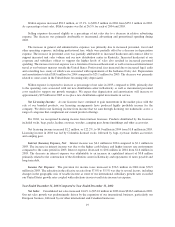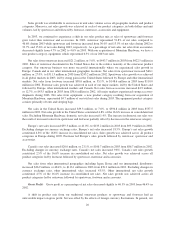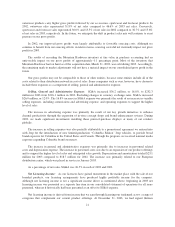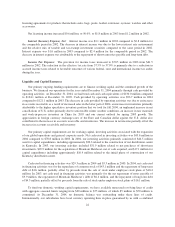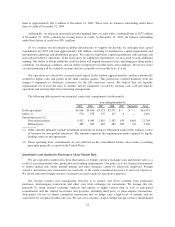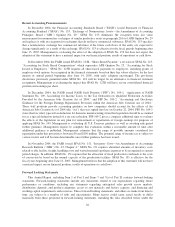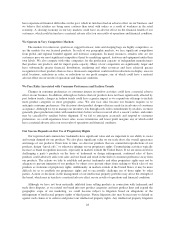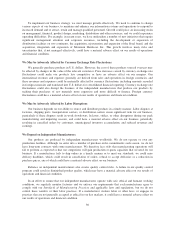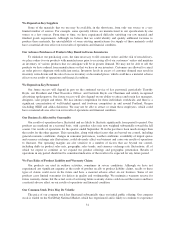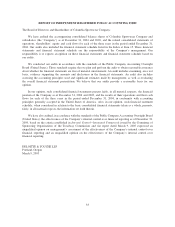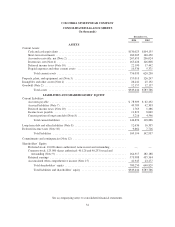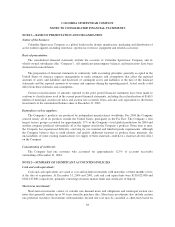Columbia Sportswear 2004 Annual Report Download - page 34
Download and view the complete annual report
Please find page 34 of the 2004 Columbia Sportswear annual report below. You can navigate through the pages in the report by either clicking on the pages listed below, or by using the keyword search tool below to find specific information within the annual report.could be costly and could divert management’s attention from the operation of our business. Adverse
determinations in any litigation could result in the loss of our proprietary rights, subject us to significant
liabilities or require us to seek licenses from third parties, which may not be available on commercially
reasonable terms, if at all. Any intellectual property litigation could have a material adverse effect on our results
of operations and financial condition.
Our Success Depends on Our Distribution Facilities
Our ability to meet customer expectations, manage inventory, complete sales and achieve objectives for
operating efficiencies depends on the proper operation of our existing distribution facilities, the development or
expansion of additional distribution capabilities and the timely performance of services by third parties
(including those involved in shipping product to and from our distribution facilities). In the United States, we
rely primarily on our distribution centers in Portland, Oregon and Robards, Kentucky; in Canada, we rely
primarily on our distribution center in Strathroy, Ontario; and in Europe we rely primarily on our distribution
center in Cambrai, France.
The implementation and performance of our Kentucky distribution facility is subject to many risks generally
associated with transition and startup activities, including the risk that the new distribution facility may not
successfully handle distribution activities and the risk that the transition may be disruptive to our business. Our
distribution facilities in the United States and France are highly automated, which means that their operations are
complicated and may be subject to a number of risks related to computer viruses, the proper operation of
software and hardware, electronic or power interruptions, or other system failures. Risks associated with
upgrading or expanding these facilities may significantly disrupt our operations.
Our distribution facilities could also be interrupted by disasters, such as earthquakes (which are known to
occur in the Northwestern United States) or fires. We maintain business interruption insurance, but it may not
adequately protect us from the adverse effect that could be caused by significant disruptions in our distribution
facilities.
Our Success Depends on Our Information Systems
Our business is increasingly reliant on information technology. Information systems are used in all stages of
our production cycle, from design to distribution, and are used as a method of communication between
employees, our subsidiaries overseas, as well as our customers. We also rely on our information systems to
allocate resources and forecast operating results. System failures or service interruptions may occur as the result
of a number of factors, including computer viruses, hacking or other unlawful activities by third parties, disasters,
or failure to properly protect, repair or maintain systems. Any interruption of critical business information
systems may have a material adverse affect on our results of operations and financial condition.
Our Success Depends on Our Growth Strategies
We face many challenges in implementing our growth strategies. For example, our expansion into
international markets involves countries where we have little sales or distribution experience and where our
brand is not yet widely known. Expanding our product categories involves, among other things, gaining
experience with new products, gaining consumer acceptance, and establishing and protecting intellectual
property rights. Increasing sales to department stores, and improving the sales productivity of our customers, will
each depend on various factors, including strength of our brand name, competitive conditions, our ability to
manage increased sales and future expansion, the availability of desirable locations and the negotiation of terms
with retailers. Future terms with customers may be less favorable to us than those under which we now operate.
Large retailers in particular increasingly seek to transfer various costs of business to their vendors, such as the
cost of lost profits from product price markdowns.
29


